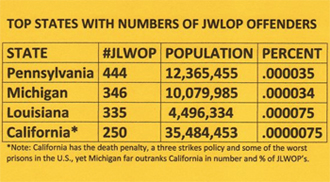Battle on behalf of juvenile lifers picks up steam in Michigan, California
By Diane Bukowski | Last updated: Sep 16, 2011 - 1:05:47 PMWhat's your opinion on this article?

|
Many juvenile lifers, those sentenced to die in prison for crimes committed when they were under the age of 18, and their advocates hailed O'Meara's decision July 11 in Hill v. Snyder (USDC Case No. 10-14568). While striking eight of the nine plaintiffs, all but Keith Maxey, who was sentenced in 2007, from the case on time limit issues, the judge left alive key elements relating to the U.S. Supreme Court's 2009 decision in Graham v. Florida.
In that case, the nation's highest court ruled that it is unconstitutional to sentence juveniles to life without parole in non-homicide cases.
“Plaintiffs argue that the Graham case changed the legal landscape with respect to the Eighth Amendment [cruel and unusual punishment] … The court agrees that Graham represents an evolution in Eighth Amendment jurisprudence that creates the possibility of relief for Plaintiffs on a claim that was previously unlikely to be viable,” O'Mera said.
O'Meara ruled that Michigan's claims that the Graham v. Florida decision barred any consideration of claims by juvenile lifers involved in homicide cases did not hold water.

|
He also cited the U.S. Supreme Court's ruling in Roper v. Simmons, which outlawed the death penalty for those who were juveniles when their crimes were committed, as another example of a ruling recognizing that the treatment of juvenile offenders should be differentiated from those who are mature.
Later, he denied a motion by the National Organization of Victims of Juvenile Lifers to file an amicus brief in the case after they missed the deadline.
Attorney Deborah LaBelle of the Michigan American Civil Liberties Union (ACLU), co-counsel for the plaintiffs in the case, said O'Meara's decision is a “first step.”
“By ignoring a child's potential for rehabilitation and denying judges and juries any discretion, the state doles out unforgiving sentences that violate basic fairness and human rights principles.” LaBelle said. “This decision is the first step toward correcting this fundamental injustice”
Edward Sanders, who has been in prison since 1975, convicted of first-degree murder at the age of 17, but not as the shooter, earned his bachelor's degree in Michigan's prisons while college education was still part of the Michigan Department of Corrections (MDOC) curriculum. He has studied law and acted as a “jail-house lawyer” for many years since.
“The District opinion came out just about as I viewed it—hold on to just one plaintiff which is what is needed,” Sanders said. “... Everything the court said about Graham v. Florida reads very much on point... . This was the best outcome any plaintiff could ask for. The defendants have nothing to appeal. They would not want to take this to any appeals court and have it upheld.”
Sanders said ongoing legal proceedings in the suit would “allow defense and appeals attorneys around the state to use this discovery and expert reports. This may move Michigan lawmakers sooner or later Allah willing.”
Attorney Kimberly Thomas, writing about Graham v. Florida in the Michigan Bar Journal, agreed.
“This scrutiny should be a signal to Michigan to examine its own jurisprudence on juveniles receiving sentences of life without parole,” Thomas said. “Michigan has the second-highest number of persons serving sentences of life without parole for offenses committed when they were 17 years old or younger. Michigan's constitution, article 1, §16, provides broader protection than the federal constitution under its analogous ban on ‘cruel or unusual punishment.' Further... . in many cases, juveniles sentenced to life without parole in Michigan will never have a judge assess anything about their individual culpability, maturity, or relative role in the offense.”
The state, however, essentially claims in its interlocutory motion for leave to appeal and for a stay of the proceedings that it has the right to contest O'Meara's assessment of the U.S. Supreme Court decisions.
This is while Michigan plans to spend $2 billion a year on its prison system beginning Oct. 1 under Governor Rick Snyder, $11 million more than last year. At the same time, 15,000 families, including children and babies, will be cut from state assistance effective Oct. 1, supposedly saving $75 million a year, leaving them to starve in the streets.
Snyder did not see fit to comply with a plan laid out in a March 2011 symposium that would cut $500 million from the prison budget. The symposium, “Finding the Path to a $1.5 Billion Corrections Budget,” was not a gathering of wild-eyed radicals, but instead a joint effort of the generally conservative Citizens Research Council, the Center for Michigan, and the Citizens Alliance on Prisons and Public Spending.
According to the Center for Michigan, there are 18 reasons for cutting Michigan's prison budget.
It cites the first five as follows: “1) Inflation-adjusted prison expenses are up 10-fold since 1973; 2) The prison system has grown from 2 percent of state general fund budget to 23 percent since 1973. 3) For many reasons, other states are finding far more strategic, and future-oriented investments for their tax dollars. For example, for every dollar Michigan spends on universities, we spend $1.19 on prisons. For every dollar Minnesota spends on universities, it spends 17 cents on prisons. 4) Since 1973, Michigan's prison population has grown 474 percent, much faster than the crime rate. 5) The average stay in a Michigan prison was 28 months in 1981. By 2005, it had grown to 44 months.”
Many states have already outlawed juvenile life without parole sentences, or have no one serving them, according to Human Rights Watch (HRW).
“Commendably, twelve states either forbid JLWOP or presently have no such juvenile offenders that we know of serving that sentence,” says HRW. “The states that currently prohibit JLWOP are: Alaska, Colorado, Kansas, Kentucky, Montana, New Mexico, and Oregon. The states where there are no people known to be serving JLWOP are: Maine, New Jersey, New York, Vermont, and West Virginia. There is also no one known to be serving a JLWOP sentence in the District of Columbia. The federal government does sentence youth to LWOP—there are currently at least 36 people serving JLWOP in federal prison.”
Altogether, according to The Juvenile Justice Project of Louisiana, ONE-HALF of states in the country either have abolished JLWOP or have less than 10 individuals serving these sentences.
According to HRW, there were 2,750 individuals serving juvenile life without parole as of 2009.
The map shown, by the national ACLU, shows their distribution by state as of 2007. Pennsylvania, Michigan, Louisiana and California have the highest numbers and rates, with Michigan running second in total numbers, and barely third in per capita rate.
The legal battle California
Senate Bill 9, authored by State Senator Leland Yee, moved to its third reading prior to approval Sept. 2. Most believe it is likely to be approved.
The Huffington Post reported Aug. 17, “According the bill, defendants who were sentenced to life with no parole for a crime committed as a minor would be eligible to apply for a lesser sentence of 25 years to life.
“‘This has been widely called a ‘painfully modest' bill, especially in light of the rest of the world,' Adam Keigwin, Senator Yee's chief of staff, told The Huffington Post. ‘No other country sentences kids to die in prison.'
“If the bill passes, an eligible defendant would need to first serve 15 years before submitting a statement of remorse, as well as evidence supporting work towards rehabilitation. Defendants would have three opportunities to apply. If accepted, a case would then be reviewed and considered for a lesser sentence. As a minimum, defendants would need to serve at least 25 years total, with no exceptions. But the bill would give some defendants the opportunity to someday live outside of prison.”
Yee, who is a child psychologist, said, “The neuroscience is clear – brain maturation continues well through adolescence and thus impulse control, planning, and critical thinking skills are not yet fully developed/ SB 9 reflects that science provides the opportunity for compassion and rehabilitation that we should exercise with minors. SB 9 is not a get-out-of-jail-free card; it is an incredibly modest proposal that respects victims, international law, and the fact that children have a greater capacity for rehabilitation than adults.”
Prosecutors here in Michigan, including Wayne County's Kym Worthy, and Oakland County'sJessica Cooper, testified against earlier bills that were even more stringent than California's. Those bills died in session.
But San Francisco District Attorney George Gascón testified in support of SB 9 at a hearing, saying, “I recognize the ability of young people to reform their behavior and rehabilitated as they mature. SB 9 holds youth responsible for their actions. It creates a rigorous system of check and balances, and provides a limited chance for young offender to prove they have changed – both to a judge and to a parole board.”
Here in Michigan, the hopes of over 350 individuals serving JLWOP, having been repeatedly thwarted at the legislative level, by county prosecutors such as Worthy and Cooper, and by state courts, now rest to a great degree on the speedy progress of Hill v. Snyder in the federal court.
INSIDE STORIES AND REVIEWS
-
-
About Harriett ... and the Negro Hollywood Road Show
By Rabiah Muhammad, Guest Columnist » Full Story -
Skepticism greets Jay-Z, NFL talk of inspiring change
By Bryan 18X Crawford and Richard B. Muhammad The Final Call Newspaper @TheFinalCall » Full Story -
The painful problem of Black girls and suicide
By Charlene Muhammad -National Correspondent- » Full Story -
Exploitation of Innocence - Report: Perceptions, policies hurting Black girls
By Charlene Muhammad -National Correspondent- » Full Story -
Big Ballin: Big ideas fuel a father’s Big Baller Brand and brash business sense
By Bryan Crawford -Contributing Writer- » Full Story






 Click Here Stay Connected!
Click Here Stay Connected!








